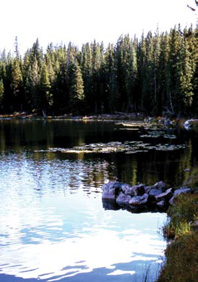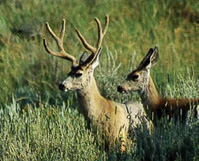Fishing Strategies

The angling strategy is to start fishing the weed bed areas first because this is the most likely spot to find feeding fish. Take into account the lake’s temperature, light intensity, and oxygen content. Next, find where optimal conditions coincide within the weed bed areas. For example, if light intensity is high, fish the darker drop-off areas and channels; likewise, if the water temperature is too warm in the shallows, seek these same areas. Usually, a lake’s highest oxygen concentration will be in the weed bed areas because this is where oxygen is produced by photosynthesis. During low light times, fish are safer to venture out into the shallow, weed bed areas. Fish this water thoroughly, especially the shaded spots adjacent to the weed beds.
During insect emergent times, fish will be drawn to the weed beds to feed; however, at non-emergent times, fish migrate to the nearby safety of the channels and drop-offs. Fishing directly over submerged weed beds is perhaps the most preferred location. Select the optimal sinking line which will suspend your fly just about one foot over these weed beds. Weed guards on fly patterns can be helpful.
Riparian growths, such as reeds and cattails, afford structure that can attract fish. Often, fish hang out just on the edge of these growths. During a damselfly migration the swimming nymphs target these structures for hatching destinations by crawling out of the water onto them to metamorphose. Fish lie in wait to intercept them; also, terrestrial insects inhabit reeds. A wind breeze may topple into the water a grasshopper, ant or a beetle, and fish await these morsels. The transitional waters are the in-between places separating a lake’s shallows from its depths. The junction areas where the shallows and the depths meet are prime fishing locations. Here fish migrate to and from each location. Daily movement patterns consist of fish leaving the shallows after the morning feed and again returning to the shallows in

the evening. These transitional areas are the fish’s commuting routes. Any bottom structures such as rocks, weeds, or downed trees, enhance transitional waters.
Rocky shorelines are similar to weed beds in growing aquatic insects. A rocky point extending out into the lake provides a structure for fish to cruise around foraging for food. Additionally, baitfish are found in these places and they attract larger predatory fish. Crawfish are common to rocky areas and provide a staple for larger fish. An abrupt rocky shoreline can signify the deepest part of a lake and cooler depths afford a likely fish lie during hot weather conditions.
Cliffs and deep water can occur together as the shoreline cliff extends out into the lake. Additionally, shadows from the cliff furnish cover that attracts fish. These are good places to fish during the heat of the day because these shaded areas contain water that is cooler.
Underwater springs are prominent fishing locations because they are a source of reliable constant temperature and oxygenated water. During both severe hot and cold times fish will seek these springs in astonishing numbers. At these times springs can provide tremendous angling.

© 2025 The Gale Group, Inc. All rights reserved.
© 2025 Perigee Learning LLC. All rights reserved.
LoveTheOutdoors.com is owned and operated by Advameg, Inc. © 2025 Advameg, Inc.
Camping Adventures • Dutch Oven Cooking • Sports Knots
Fly Tying • Freshwater Fishing • Fly Fishing

